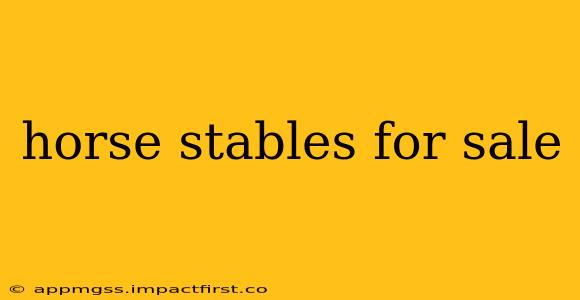Finding the perfect horse stables for sale can be an exciting yet daunting task. Whether you're a seasoned equestrian looking to upgrade your facilities or a new horse owner seeking a suitable home for your equine companions, this guide will help you navigate the process. We'll cover everything from considering your needs and budget to understanding the legal aspects of purchasing a stable.
What to Consider When Buying Horse Stables
Before you start your search, it's crucial to define your requirements. This will significantly streamline your search and prevent wasted time looking at unsuitable properties. Key factors to consider include:
- Number of horses: How many horses do you currently own, and do you plan to expand your herd in the future? The stable's capacity needs to accommodate your current and future needs.
- Type of stable: Do you need individual stalls, open barns, or a combination? Consider the climate and your horses' specific needs. Some horses thrive in open barns, while others prefer the security of individual stalls.
- Amenities: What additional amenities are essential? Think about things like riding arenas, paddocks, wash stalls, tack rooms, hay storage, and potentially even staff quarters.
- Location: Proximity to veterinary services, farriers, and riding trails is critical. Consider commuting distance and accessibility for you and your horses.
- Land size: How much land do you require for pasture, paddocks, and potential future expansion?
- Budget: Determine a realistic budget that encompasses not only the purchase price but also ongoing maintenance, insurance, and potential renovations.
What are the different types of horse stables available?
There's a wide variety of horse stable designs available, each with its own pros and cons. Understanding these differences is vital in selecting the right one for your needs and budget.
- American Barns: Known for their distinctive gambrel roofs, these barns offer ample space and are ideal for larger operations.
- Monitor Barns: Characterized by a central aisle and stalls on either side, these offer good ventilation and efficient space utilization.
- Dutch Barns: Similar to monitor barns, but with a slightly different roof design and often incorporating haylofts.
- Open-front Barns: These barns provide excellent ventilation and natural light, beneficial for horses in milder climates. They may require additional weather protection in colder areas.
How much does it cost to buy horse stables?
The cost of horse stables for sale varies significantly depending on several factors:
- Location: Properties in desirable areas with ample land command higher prices.
- Size and capacity: Larger stables with more features and amenities will be more expensive.
- Condition: Newly built stables will cost more than older ones requiring renovations.
- Included amenities: The presence of riding arenas, paddocks, and other amenities increases the overall cost.
You can expect prices to range from a few tens of thousands of dollars for smaller, basic stables to millions of dollars for large, high-end equestrian properties with extensive amenities.
What are the legal aspects of buying horse stables?
Buying a horse stable involves various legal considerations, including:
- Property inspection: A thorough inspection is essential to identify any structural issues or potential problems. Consider engaging a professional inspector specializing in equestrian properties.
- Zoning regulations: Verify that the property's zoning complies with your intended use for horse keeping.
- Environmental concerns: Check for potential environmental hazards like contaminated soil or water sources.
- Title search: Ensure a clear title to prevent future ownership disputes.
- Legal representation: Having a real estate lawyer review the contract and ensure your interests are protected is highly recommended.
What should I look for during a horse stable inspection?
A detailed inspection is crucial before finalizing any purchase. Here are key aspects to check:
- Structural integrity: Examine the foundations, roof, walls, and overall structural soundness.
- Stalls and fencing: Inspect the condition of stalls, fencing, and gates for safety and durability.
- Drainage and utilities: Assess drainage systems, water supply, and electrical systems.
- Ventilation and lighting: Ensure adequate ventilation and lighting in all areas.
- Environmental factors: Note the presence of any potential hazards such as poisonous plants.
By carefully considering these factors, conducting thorough inspections, and seeking professional advice, you can confidently navigate the process of buying horse stables and find the perfect equestrian property to suit your needs. Remember that patience and due diligence are key to a successful purchase.
